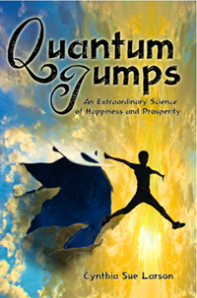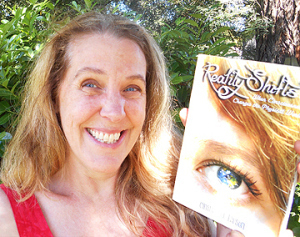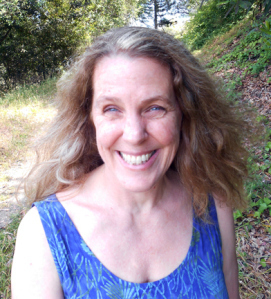Cynthia Sue Larson's Blog, page 15
September 3, 2014
Get into “The Zone” Where Doing Less is Much, Much More
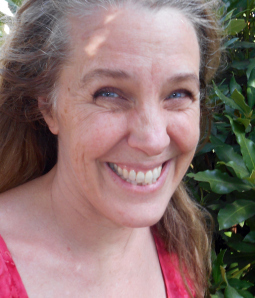 There is a saying I’ve often heard in martial arts classes that, “If you’re putting lots of muscle into a certain escape or technique, you’re doing it wrong.” While this may at first seem counter-intuitive, since one might assume that greater forcefulness is always good in self defense, ancient wisdom teaches that minimal effort is required when using proper technique. In fact, so little effort is needed when correctly applying technique, that sometimes it can feel to the person doing the technique that nothing is being done at all. Yet with remarkably little muscle power, by applying just the right force and momentum to the right place at the right time, a very small person can defend themselves against a much larger opponent.
There is a saying I’ve often heard in martial arts classes that, “If you’re putting lots of muscle into a certain escape or technique, you’re doing it wrong.” While this may at first seem counter-intuitive, since one might assume that greater forcefulness is always good in self defense, ancient wisdom teaches that minimal effort is required when using proper technique. In fact, so little effort is needed when correctly applying technique, that sometimes it can feel to the person doing the technique that nothing is being done at all. Yet with remarkably little muscle power, by applying just the right force and momentum to the right place at the right time, a very small person can defend themselves against a much larger opponent.
I recently read a blog post that reminded me of the importance of doing less with more, Save Time and Do Less, that got me thinking about applying this concept in daily life. The basic concepts presented in this article suggest you can ask seven simple questions to help optimize various aspects of your life, which can help ensure that you aren’t inadvertently wasting time. These tips include such important concepts as remembering to: say “no,” delegate tasks, and eliminate non-essentials. These questions are an excellent start to ensuring you gain more time to do what you love most by doing less of what matters least. I love all these tips, and as a writer and author, I’d add making sure you have times when you aren’t jumping to immediately reply to every phone call, email, chat, text, facebook post and tweet.
In addition to these wonderful suggestions, I’ve found there exists a level beyond these basic tips available to me if and when I get into “The Zone” of meditative awareness. From such a state of awareness, I realize that who I think I am–the “Me” who is watching and observing the world–is also the awareness watching and observing my thoughts and feelings. From such a state of elevated awareness, I am more fully present in each moment, and thus much more genuinely responsive to doing and saying exactly the best thing at the right time.
Getting into “The Zone” with Meditation
Meditation is not as hard as you might think. Any time you enjoy the space between your thoughts, such as when gazing out off into the distance at leaves rustling in the breeze, or clouds floating by in the sky, you are in a meditative state of mind. Enjoying such moments brings tremendous value from accessing a kind of expanded awareness that members of the Seattle Seahawks recently utilized in winning the Super Bowl this year. Offensive tackle Russell Okung was quoted by ESPN as saying,
“Meditation is as important as lifting weights and being out there on the field for practice. It’s about quieting your mind and getting into certain states where everything outside of you doesn’t matter in that moment. There are so many things telling you that you can’t do something, but you take those thoughts captive, take power over them, and change them.”
The Seattle Seahawks were coached to include meditation each and every day, and as a result, found that they moved together much more cohesively, much more effortlessly, with responses to unpredictable developments in the game happening with an extraordinary level of coordination and finesse.
What Makes the Difference of Success and Failure in Your Life?
When you look back at past successes and failures, would you tend to attribute results more to physical events, or mental frame of mind? If you answered, “Mental,” you’re recognizing the importance of benefiting from staying on task without interference from intrusive distracting thoughts.
When I meditate, I experience a sense of moving in synchronization with what I’m doing and who I’m working with. There’s a possible explanation for this from quantum physics, which is called coherence. You can observe coherence in Nature when you see a flock of starlings or a school of fish changing direction simultaneously. There is a sense of shared consciousness happening, which may just be due to these animals getting into “The Zone” in a state of meditative awareness of being awareness–of being aware. This is a way of finding you are now doing exactly the right thing at the right time, saying the best possible thing to the most appropriate person, and feeling inspired to pursue those tasks and activities that most benefit you and others.
And best of all, it only takes a few minutes every day to get into “The Zone” and start experiencing the joys of synchronicity!


August 31, 2014
Cynthia Sue Larson Interviews Se��n �� Nuall��in
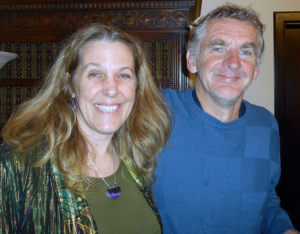
Cynthia Sue Larson with Se��n �� Nuall��in
I met author Se��n �� Nuall��in��at the Foundations of Mind conference��that Se��n organized and facilitated in Berkeley in February 2014. The first Foundations of Mind conference took place in 1995 in Sheffield, England, with��other past conferences taking place in Dublin, Ireland, and this marks the first year that these conferences have taken place in the United States.
What’s impressed me most about��Se��n is his single-minded dedication to facilitating a truly extraordinary and groundbreaking series of scientific conversations that recognize areas of true progress toward a more complete understanding of consciousness–which is my favorite subject! You can glean a sense of the excitement generated by continuing seminars and talks facilitated through Se��n’s Foundations of Mind in this last sentence of it’s mission statement:
“We remain open to the idea that reality is an entangled nexus and that we cannot truly perceive without changing it. That has, of course, been accepted in physics since the 1930s; but the consequences may be quite different than you imagine. We invite you to our conferences and workshops to explore this.”
I’m deeply��grateful to��Se��n for��granting me this��interview where he��tells us about his new book,��One Magisterium,��and new��course on consciousness, Neuroscience and Philosophy of Mind.
______________________
Cynthia:��First, I’d love to thank you for organizing the Foundations of Mind conference and seminars that I’ve so greatly enjoyed attending this year. There’s something truly extraordinary happening at this time in history, that I most keenly sense when reading your books and attending the Foundations of Mind events you’ve sponsored. I get a sense that we’re on the verge of a great intellectual revolution having to do with a whole new way of comprehending consciousness. What most inspires you to explore the subject of consciousness, and how do you feel this subject is important at this time?
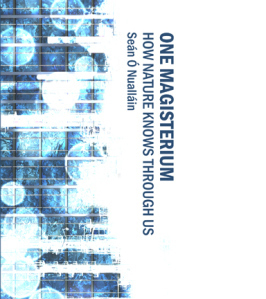 Se��n: ��About the times we live in, Jacob Needleman put it very well in his blurb for my new book, “One Magisterium” (CSP, Sept 2014); “From first page to the last, a sustained and dazzling burst of light illuminating the fundamental questions and the presumed ���answers��� within the scientific, philosophical and spiritual world now radically changing before our eyes.” Consciousness is one way into this phenomenon of the “scientific, philosophical and spiritual world now radically changing before our eyes.” Scientists in general are naturally uncomfortable with the subjective world; there is indeed a case that it is best left to artists and spiritual guides. Yet we can say some coherent and responsible things while remaining responsible scientifically.
Se��n: ��About the times we live in, Jacob Needleman put it very well in his blurb for my new book, “One Magisterium” (CSP, Sept 2014); “From first page to the last, a sustained and dazzling burst of light illuminating the fundamental questions and the presumed ���answers��� within the scientific, philosophical and spiritual world now radically changing before our eyes.” Consciousness is one way into this phenomenon of the “scientific, philosophical and spiritual world now radically changing before our eyes.” Scientists in general are naturally uncomfortable with the subjective world; there is indeed a case that it is best left to artists and spiritual guides. Yet we can say some coherent and responsible things while remaining responsible scientifically.
Cynthia:��You raise an important point that many scientists are reticent to publicly discuss subjective experience, even though their own subjective experiences are primary motivators behind the scientific research they do. There seems to be a difference of opinion by many people that if there is to be but “One Magisterium,” or primary way of comprehending reality, it will be based on science, while others feel it should be primarily spiritual. Do you sense humanity is on the verge of finding a way to reconcile these differences, perhaps starting with saying some coherent, responsible things about consciousness?
Se��n: ��Great question! Of course, historically the magisterium is church teaching. The Galileo incident put paid to that; not so much Galileo���s�� contemporary clerical opponents, who were actually quite sophisticated, but the retards who were pushing biblical geocentrism well into the 19th century.
After SJ Gould, there is a consensus that Galileo���s�� contemporary clerical opponents are correct; the magisterium of the Church is faith and morals (���how to go to heaven���), and that of science external reality (���how the heavens go���). As an Irish recovering Catholic, I was particularly engaged in this debate; the fact that it still goes on is attested by the recent movie ���Cavalry��� with Brendan Gleeson as a rural Irish priest with nothing to offer eventually except his willingness to die as an expiation for the rape of children by his church.
Ironically, it was a Belgian Priest (George le Maitre) who invented modern cosmology with his notion of the singularity/ ���primeval atom.��� Yet he vociferously protested against the Vatican���s adopting this as proving the biblical account of creation���������
On the other side, we have ���thinkers��� like Dawkins and Harris who argue that science has advanced enough to come to moral conclusions. Dawkins��� autobiography is interesting; it looks like he had the makings of a decent computational biologist before the ���selfish gene.��� On the other hand, there are too many kludges in his early experimental apparatus for his results to be credible. The Harris case is simpler; after Ed Vul, who spoke at Foundations of Mind (FoM), we frankly do not have to believe any fMRI results of the kind Harris adduces.
I leave this answer with a few more trends the book addresses;
-�� �� �� ��Why is it that the people who believe in a religious basis (from Mother Teresa to Mathieu Richard to yes, Michelle Bachman) tend to work hardest for others? The notion of an objective realm of morality��seems vital
–�� �� �� ��What of subjectivism in the arts? Currently, young�� Americans are deserting the only sophisticated arts form created here ie jazz
–�� �� �� ��What of the mess Google and others are making of natural language processing?The book and course put a lot of these issues together.
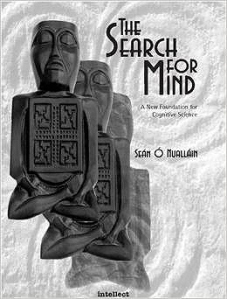 Cynthia:��I am very much looking forward to reading your new book, “One Magisterium”! What I find personally most significant about your previous books, including The Search for Mind and Being Human: The Search for Order is the apparent ease with which you bring ideas together from a multitude of disciplines to create a cohesive holistic presentation of consciousness at a level that I’ve seen few other authors match. There appears to be a larger picture view of “how the heavens go” than some more narrowly focused scientists and authors recognize. How would you advise those interested in getting caught up to speed with new findings about the nature of consciousness to begin?
Cynthia:��I am very much looking forward to reading your new book, “One Magisterium”! What I find personally most significant about your previous books, including The Search for Mind and Being Human: The Search for Order is the apparent ease with which you bring ideas together from a multitude of disciplines to create a cohesive holistic presentation of consciousness at a level that I’ve seen few other authors match. There appears to be a larger picture view of “how the heavens go” than some more narrowly focused scientists and authors recognize. How would you advise those interested in getting caught up to speed with new findings about the nature of consciousness to begin?
Se��n: ��Cognitive Science completes the circle of explanation in the sciences. It can also hint at solutions to moral and aesthetic dilemmas, often explained away through postmodernism/subjectivism. It must obey laws of inheritance of facts and constraints; just as biology inherits facts and constraints from physics, so must Cognitive Science inherit facts and constraints from biology. These include conservation laws (physics), chaotic dynamics (both biology and physics); and it is likely therefore that concepts like harmonic oscillators and bifurcations should be pervasive in Cognitive Science.
Yet the situation is more complex. For example, the concept�����information��� in physics has an energetic dimension (Landauer), a��spatial dimension (Susskind) and, as quantum theory teaches us, it��determines to some extent what we considered objective reality.��Likewise, it is arguably impossible to continue discourse about��biology without granting that codes/syntax are intrinsic to the subject. Cognitive Science also inherits these constraints.
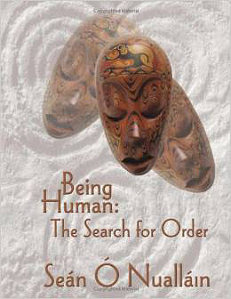 We must go deeper still. We find that mathematics, the most elliptical��and precise language with which we describe reality, constrains us in��certain ways. Tensors of various orders, from scalars through vectors��to the Riemann and Ricci tensors, are distinct with the latter two not��describable in terms of the former. Our explanation patterns in��Cognitive Science must honour this. So fMRI, which specifies a scalar,��cannot be an explanation of mind, nor can vectors; it is a category��error to suggest they can.
We must go deeper still. We find that mathematics, the most elliptical��and precise language with which we describe reality, constrains us in��certain ways. Tensors of various orders, from scalars through vectors��to the Riemann and Ricci tensors, are distinct with the latter two not��describable in terms of the former. Our explanation patterns in��Cognitive Science must honour this. So fMRI, which specifies a scalar,��cannot be an explanation of mind, nor can vectors; it is a category��error to suggest they can.
Our explanation patterns in Cognitive Science must also honour what��we learned in the 20th century from G��del, Church et al about the��limits of formal systems. This can paradoxically leave us open to non-deterministic thought. So we can indeed, following G��del,��Schr��dinger and other greats, assert the existence of the spiritual��while remaining completely scientifically responsible. However, we are not going to get a ���solution��� to the so-called ���hard problem,��� an��algorithm mapping all neural data to experience; that is also a��category error. We are going to be able to argue for a substratum of subjectivity and indeed free will in conscious experience while��remaining scientific. The job of eliciting subjective states belongs��to great artists and spiritual leaders, of whom we have a decreasing number.
Cynthia:��I can see that you’ve accurately identified some rather serious shortcomings currently being made by many researchers and authors–that they are making category errors at critical junctures. I love the work you’ve been doing with your Foundations of Mind conference series and your new book, “One��Magisterium” to help people realize the importance of building upon sturdy foundations of knowledge in philosophy, math, physics, biology, linguistics, and computer science. Clearly there is no need for a high-tech new-fangled version of phrenology to provide a solution to the so-called “hard problem” of why people have subjective experiences of consciousness using fMRI. And clearly there is a need to create and test scientific hypotheses for how free will and other cognitive functions operate. How important do you feel it to be that cognitive science and consciousness researchers adopt a common language, and how would you envision such a shared common language being formed?
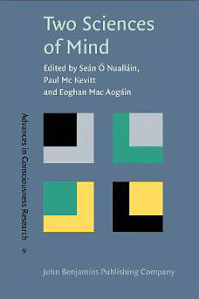 Se��n: ��In 1997 I published the book Two Sciences of Mind (it precedes��Shambala’s use of this phrase) to indicate the necessaity for a��distinction between what Needleman called “inner” and “outer”��(cognitive science ) empiricism.
Se��n: ��In 1997 I published the book Two Sciences of Mind (it precedes��Shambala’s use of this phrase) to indicate the necessaity for a��distinction between what Needleman called “inner” and “outer”��(cognitive science ) empiricism.
In my course, you’ll find certain intersections; the��Noe/O’Regan/Freeman work on sensorimotor behavior, which is common to��cognitive science and��consciousness research. Yet that does not extend into domains like��the arts, where artists are using a much larger palette precisely to specify inner states.
Cognitive science�� can tell us that jazz uses much more complex��computations than rap; in fact we can specify the stack in say��Beethoven’s 5th, whose opening has a fractal structure. That may lead��us to suspect there is something more going on, the opening to��objective�� reality that Beethoven felt he was doing. And at that note��of opening to reality of I’d like to end this interview; it is��precisely this sense of an objective world to which we must conform��and which can edify us that we in the west have lost. To regain the��respect of fundamentalists like ISIS, we might consider this instead��of just bombs.
Cynthia:��Thank you, Se��n, for making time for this interview, and for sharing news of your new book and your course on consciousness, Neuroscience and Philosophy of Mind. ��I’m glad to announce that this online course is available to students anywhere in the world, and it starts this September 2nd. For a cost of $75 US, this course is a bargain, since this is the same course taught for credit at Stanford University by the same instructor, and students who complete this course will receive certificates of completion. It includes video presentations from the entire proceedings of the 2014 Foundations of Mind conference, and ��I encourage all interested to learn more at: http://consciousnesscourse.blogspot.com/ ��and to register online at:��http://foundationsofmind.org/register.html
��
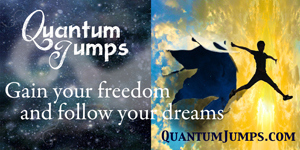


Cynthia Sue Larson Interviews Seán Ó Nualláin

Cynthia Sue Larson with Seán Ó Nualláin
I met author Seán Ó Nualláin at the Foundations of Mind conference Seán that organized and facilitated in Berkeley in February 2014. The first Foundations of Mind conference took place in 1995 in Sheffield, England, with other past conferences taking place in Dublin, Ireland, and this marks the first year that these conferences have taken place in the United States.
What’s impressed me most about Seán is his single-minded dedication to facilitating a truly extraordinary and groundbreaking series of scientific conversations that recognize areas of true progress toward a more complete understanding of consciousness–which is my favorite subject! You can glean a sense of the excitement generated by continuing seminars and talks facilitated through Seán’s Foundations of Mind in this last sentence of it’s mission statement:
“We remain open to the idea that reality is an entangled nexus and that we cannot truly perceive without changing it. That has, of course, been accepted in physics since the 1930s; but the consequences may be quite different than you imagine. We invite you to our conferences and workshops to explore this.”
I’m deeply grateful to Seán for granting me this interview where he tells us about his new book, One Magisterium, and new course on consciousness, Neuroscience and Philosophy of Mind.
______________________
Cynthia: First, I’d love to thank you for organizing the Foundations of Mind conference and seminars that I’ve so greatly enjoyed attending this year. There’s something truly extraordinary happening at this time in history, that I most keenly sense when reading your books and attending the Foundations of Mind events you’ve sponsored. I get a sense that we’re on the verge of a great intellectual revolution having to do with a whole new way of comprehending consciousness. What most inspires you to explore the subject of consciousness, and how do you feel this subject is important at this time?
Seán: About the times we live in, Jacob Needleman put it very well in his blurb for my new book, “One Magisterium” (CSP, Sept 2014); “From first page to the last, a sustained and dazzling burst of light illuminating the fundamental questions and the presumed “answers” within the scientific, philosophical and spiritual world now radically changing before our eyes.” Consciousness is one way into this phenomenon of the “scientific, philosophical and spiritual world now radically changing before our eyes.” Scientists in general are naturally uncomfortable with the subjective world; there is indeed a case that it is best left to artists and spiritual guides. Yet we can say some coherent and responsible things while remaining responsible scientifically.
Cynthia: You raise an important point that many scientists are reticent to publicly discuss subjective experience, even though their own subjective experiences are primary motivators behind the scientific research they do. There seems to be a difference of opinion by many people that if there is to be but “One Magisterium,” or primary way of comprehending reality, it will be based on science, while others feel it should be primarily spiritual. Do you sense humanity is on the verge of finding a way to reconcile these differences, perhaps starting with saying some coherent, responsible things about consciousness?
Seán: Great question! Of course, historically the magisterium is church teaching. The Galileo incident put paid to that; not so much Galileo’s contemporary clerical opponents, who were actually quite sophisticated, but the retards who were pushing biblical geocentrism well into the 19th century.
After SJ Gould, there is a consensus that Galileo’s contemporary clerical opponents are correct; the magisterium of the Church is faith and morals (“how to go to heaven”), and that of science external reality (“how the heavens go”). As an Irish recovering Catholic, I was particularly engaged in this debate; the fact that it still goes on is attested by the recent movie “Cavalry” with Brendan Gleeson as a rural Irish priest with nothing to offer eventually except his willingness to die as an expiation for the rape of children by his church.
Ironically, it was a Belgian Priest (George le Maitre) who invented modern cosmology with his notion of the singularity/ “primeval atom.” Yet he vociferously protested against the Vatican’s adopting this as proving the biblical account of creation………
On the other side, we have “thinkers” like Dawkins and Harris who argue that science has advanced enough to come to moral conclusions. Dawkins’ autobiography is interesting; it looks like he had the makings of a decent computational biologist before the “selfish gene.” On the other hand, there are too many kludges in his early experimental apparatus for his results to be credible. The Harris case is simpler; after Ed Vul, who spoke at Foundations of Mind (FoM), we frankly do not have to believe any fMRI results of the kind Harris adduces.
I leave this answer with a few more trends the book addresses;
- Why is it that the people who believe in a religious basis (from Mother Teresa to Mathieu Richard to yes, Michelle Bachman) tend to work hardest for others? The notion of an objective realm of morality seems vital
– What of subjectivism in the arts? Currently, young Americans are deserting the only sophisticated arts form created here ie jazz
– What of the mess Google and others are making of natural language processing?The book and course put a lot of these issues together.
 Cynthia: I am very much looking forward to reading your new book, “One Magisterium”! What I find personally most significant about your previous books, including The Search for Mind and Being Human: The Search for Order is the apparent ease with which you bring ideas together from a multitude of disciplines to create a cohesive holistic presentation of consciousness at a level that I’ve seen few other authors match. There appears to be a larger picture view of “how the heavens go” than some more narrowly focused scientists and authors recognize. How would you advise those interested in getting caught up to speed with new findings about the nature of consciousness to begin?
Cynthia: I am very much looking forward to reading your new book, “One Magisterium”! What I find personally most significant about your previous books, including The Search for Mind and Being Human: The Search for Order is the apparent ease with which you bring ideas together from a multitude of disciplines to create a cohesive holistic presentation of consciousness at a level that I’ve seen few other authors match. There appears to be a larger picture view of “how the heavens go” than some more narrowly focused scientists and authors recognize. How would you advise those interested in getting caught up to speed with new findings about the nature of consciousness to begin?
Seán: Cognitive Science completes the circle of explanation in the sciences. It can also hint at solutions to moral and aesthetic dilemmas, often explained away through postmodernism/subjectivism. It must obey laws of inheritance of facts and constraints; just as biology inherits facts and constraints from physics, so must Cognitive Science inherit facts and constraints from biology. These include conservation laws (physics), chaotic dynamics (both biology and physics); and it is likely therefore that concepts like harmonic oscillators and bifurcations should be pervasive in Cognitive Science.
Yet the situation is more complex. For example, the concept “information” in physics has an energetic dimension (Landauer), a spatial dimension (Susskind) and, as quantum theory teaches us, it determines to some extent what we considered objective reality. Likewise, it is arguably impossible to continue discourse about biology without granting that codes/syntax are intrinsic to the subject. Cognitive Science also inherits these constraints.
 We must go deeper still. We find that mathematics, the most elliptical and precise language with which we describe reality, constrains us in certain ways. Tensors of various orders, from scalars through vectors to the Riemann and Ricci tensors, are distinct with the latter two not describable in terms of the former. Our explanation patterns in Cognitive Science must honour this. So fMRI, which specifies a scalar, cannot be an explanation of mind, nor can vectors; it is a category error to suggest they can.
We must go deeper still. We find that mathematics, the most elliptical and precise language with which we describe reality, constrains us in certain ways. Tensors of various orders, from scalars through vectors to the Riemann and Ricci tensors, are distinct with the latter two not describable in terms of the former. Our explanation patterns in Cognitive Science must honour this. So fMRI, which specifies a scalar, cannot be an explanation of mind, nor can vectors; it is a category error to suggest they can.
Our explanation patterns in Cognitive Science must also honour what we learned in the 20th century from Gödel, Church et al about the limits of formal systems. This can paradoxically leave us open to non-deterministic thought. So we can indeed, following Gödel, Schrödinger and other greats, assert the existence of the spiritual while remaining completely scientifically responsible. However, we are not going to get a “solution” to the so-called “hard problem,” an algorithm mapping all neural data to experience; that is also a category error. We are going to be able to argue for a substratum of subjectivity and indeed free will in conscious experience while remaining scientific. The job of eliciting subjective states belongs to great artists and spiritual leaders, of whom we have a decreasing number.
Cynthia: I can see that you’ve accurately identified some rather serious shortcomings currently being made by many researchers and authors–that they are making category errors at critical junctures. I love the work you’ve been doing with your Foundations of Mind conference series and your new book, “One Magisterium” to help people realize the importance of building upon sturdy foundations of knowledge in philosophy, math, physics, biology, linguistics, and computer science. Clearly there is no need for a high-tech new-fangled version of phrenology to provide a solution to the so-called “hard problem” of why people have subjective experiences of consciousness using fMRI. And clearly there is a need to create and test scientific hypotheses for how free will and other cognitive functions operate. How important do you feel it to be that cognitive science and consciousness researchers adopt a common language, and how would you envision such a shared common language being formed?
 Seán: In 1997 I published the book Two Sciences of Mind (it precedes Shambala’s use of this phrase) to indicate the necessaity for a distinction between what Needleman called “inner” and “outer” (cognitive science ) empiricism.
Seán: In 1997 I published the book Two Sciences of Mind (it precedes Shambala’s use of this phrase) to indicate the necessaity for a distinction between what Needleman called “inner” and “outer” (cognitive science ) empiricism.
In my course, you’ll find certain intersections; the Noe/O’Regan/Freeman work on sensorimotor behavior, which is common to cognitive science and consciousness research. Yet that does not extend into domains like the arts, where artists are using a much larger palette precisely to specify inner states.
Cognitive science can tell us that jazz uses much more complex computations than rap; in fact we can specify the stack in say Beethoven’s 5th, whose opening has a fractal structure. That may lead us to suspect there is something more going on, the opening to objective reality that Beethoven felt he was doing. And at that note of opening to reality of I’d like to end this interview; it is precisely this sense of an objective world to which we must conform and which can edify us that we in the west have lost. To regain the respect of fundamentalists like ISIS, we might consider this instead of just bombs.
Cynthia: Thank you, Seán, for making time for this interview, and for sharing news of your new book and your course on consciousness, Neuroscience and Philosophy of Mind. I’m glad to announce that this online course is available to students anywhere in the world, and it starts this September 2nd. For a cost of $75 US, this course is a bargain, since this is the same course taught for credit at Stanford University by the same instructor, and students who complete this course will receive certificates of completion. It includes video presentations from the entire proceedings of the 2014 Foundations of Mind conference, and I encourage all interested to learn more at: http://consciousnesscourse.blogspot.com/ and to register online at: http://foundationsofmind.org/register.html



August 8, 2014
How Your Prejudices Can Shorten or Lengthen Your Life
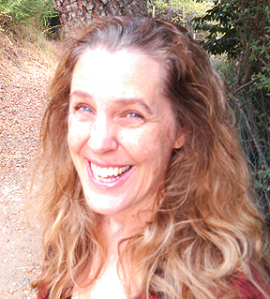
“There are only two ways to be quite unprejudiced and impartial. One is to be completely ignorant. The other is to be completely indifferent. Bias and prejudice are attitudes to be kept in hand, not attitudes to be avoided.” — Charles Curtis
—————–
The definition of prejudice in my dictionary is a “preconceived opinion that is not based on reason or actual experience.” Preconceptions are our underlying assumptions; they act as the lenses by which we see the world that henceforth color all we see. Just as we seldom notice the unique and familiar smell of our own home unless we’ve been away for quite a while, we often have no idea what our unexamined biases and prejudices are, since we take them so for granted.
“We all decry prejudice, yet are all prejudiced. ” – Herbert Spencer
The word ‘prejudice’ carries a heavy implication that some of our inner biases result in harm or injury due to unfounded dislikes and hostilities. While our underlying biases can help us make daily discernments in life, most of us know that preconceptions and prejudgments can be needlessly injurious to others. What may come as a surprise is that we seldom recognize ways our own unconscious stereotypes can boomerang back and harm ourselves.
Recent research shows that one of the best things you can do to positively improve both the length of your life and the life in your years has everything to do with your prejudices and stereotypes.
Improve Your Life by Becoming What You Think
When you think of old people, what are the first five words or phrases that come to mind? It turns out that your answer to this question could make a tremendous difference in your health and longevity in later years.
Recent research shows that our subconsciously adopted “age stereotypes” regarding our expectations of what will happen as we age makes a tremendous difference in how we actually do age. An increasing body of scientific research studies show that when seniors expect that growing older means they will become incapacitated, confused, useless, weak or devalued they are less likely to take preventive steps against such deterioration and they actually will suffer from mental and physical deterioration.
Intriguingly, when seniors believe positive stereotypes about aging, such as that older adults are wise, involved with life and satisfied, such individuals actually experience higher levels of physical and mental wellbeing. A medical research team at Yale University led by Becca Levy reported recently in !e Journal of the American Medical Association that seniors with positive biases toward aging are 44% more likely to fully recover from a bout of disability—better able to bathe, dress and walk than those with negative aging stereotypes. The research team propose that positive age stereotypes are so effective because they operate through several pathways: limiting cardiovascular responses to stress, improving physical balance, enhancing self-efficacy, and increasing peoples’ engagement in healthy behaviors.
Dr. Becca Levy is a pioneer in the field of age stereotypes and aging, and has helped us better appreciate the importance of maintaining a positive mindset around our elders, because their exposure—even subliminally—to negative age stereotypes and expectations can prove debilitating. Levy conducted many laboratory experiments with older people to observe peoples’ reactions to subliminal messages prior to attempting to complete various tasks. Levy noted that seniors who’d subliminally received negative words, such as “decrepit” had worse handwriting and slower walking speeds afterward, whereas those who saw positive words such as “wisdom” did much better.
Dr. Levy studied a database of 600 people who’d been tracked over a period of 23 years, from 1975 to 1998, to see how people’s age stereotypes influence their lives. Levy noted that participants with positive age stereotypes lived an average of 7.5 years longer than those with negative stereotypes. “This longevity gap persisted even after variables of age, gender, socioeconomic status, loneliness and functional health were considered as covariates. Participants were asked at the beginning of the research to answer either “True” or “False” to questions such as, “Things keep getting worse as I get older,” or “as you get older, you get less useful.”
Dr. Levy asks us to be more mindful of the ‘little things’ that add to quite a lot when we interact with seniors. Everything from our tone of voice, attitude, and use of loaded phrases or expressions make a huge difference. Rather than parroting whatever negative stereotypes we might have accumulated, each of us has an opportunity to “think about how to reinforce the more positive aspects of aging,” as Dr. Levy suggests.
Ask yourself again, when you think of old people, what are the first five words or phrases that come to mind? Hopefully you’re now adopting some new, positive stereotypes about the elderly! Pay attention to seniors who demonstrate these positive qualities, and imagine how you and your loved ones can get better and better with each passing year.
___________________
Excerpted from Quantum Jumps: An Extraordinary Science of Happiness and Prosperity. Quantum Jumps describes the science behind instant “manifestation,” by presenting a radical new paradigm–that we exist in an interconnected holographic multiverse in which we literally jump from one parallel universe to another.
This book encourages you to have fun trying out scientifically verified, laboratory-tested techniques to improve your life with dozens of tips you can use to bring Quantum Jumps into your daily life.
Here’s the video summary of this blog post, with a glimpse inside the book at some of the lovely illustrations:
Love always,
Cynthia Sue Larson
email Cynthia at cynthia@realityshifters.com
Let’s Connect





July 20, 2014
Cynthia Sue Larson Interviews Frank Moffatt
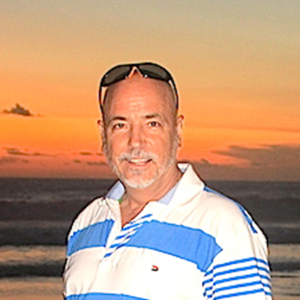
Frank Moffatt in Bangkok
Have you ever wondered why some people age gracefully, seeming like they look pretty much the same now as decades earlier, while staying actively engaged in fun activities, learning new things, and staying active… and other people slip into steady decline?
If you have noticed this and wondered, “What’s up with that?” you’ll love hearing about Frank Moffatt and his new documentary film! You could say that Frank Moffatt is a man with a mission to change the world, but that would be missing the point that simply listening to his message has the power to completely transform our lives. When I heard from Frank that he’s raising funds through an Indiegogo campaign for a new documentary movie, I was intrigued. Your Second Fifty: Rising Above the Myths of Aging is a movie designed to implement change in all who see it. Consider these facts:
By 2015, those aged 50 and older will represent 45% of the U.S. population (source: AARP). Of that 45%, many will have been subjected to limiting beliefs and myths that will unfortunately restrict them from reaching their true potential — mentally, emotionally, physically, financially and spiritually. The good news is that with proper education and guidance, these limiting beliefs and myths can be eradicated — and a fresh new outlook and approach can be established within one’s daily life.
I’m thrilled to know this movie is in the works, and honored to share some special insights from Frank Moffatt in this interview. And I hope that if you find this topic as exciting as I do, you’ll support the Your Second Fifty: Rising Above the Myths of Aging Indiegogo campaign, and share this post with friends and family!
______________________
 CYNTHIA: I’m thrilled to talk with you about your new documentary film, “Your Second Fifty,” since its message that many common beliefs about aging are untrue is a big idea that also came to my attention when I was researching and writing my most recent book, Quantum Jumps. I was stunned to learn that long-term scientific studies have shown that one of the best predictors of long, healthy lives are peoples’ biases and prejudices about the elderly. When I give talks about the science covered in Quantum Jumps, I often make the point that “If you take just one idea away from this entire presentation, improve your stereotypes about the elderly! You can improve both your longevity, and your quality of life.” What inspired you to create a movie about these ideas at this time?
CYNTHIA: I’m thrilled to talk with you about your new documentary film, “Your Second Fifty,” since its message that many common beliefs about aging are untrue is a big idea that also came to my attention when I was researching and writing my most recent book, Quantum Jumps. I was stunned to learn that long-term scientific studies have shown that one of the best predictors of long, healthy lives are peoples’ biases and prejudices about the elderly. When I give talks about the science covered in Quantum Jumps, I often make the point that “If you take just one idea away from this entire presentation, improve your stereotypes about the elderly! You can improve both your longevity, and your quality of life.” What inspired you to create a movie about these ideas at this time?
FRANK: First off I’m excited to read your book! We really have no idea of our potential and capability, especially in our second fifty. But to answer your question, I wanted to make the documentary because we are an impulsive society and people would rather sit and watch this film for an hour than sit and read a book for 6 or 7 hours. So the real question would be, what inspired me to write the book? After observing people over 50 for a year or so I was struck by the fact that some people were full of life, while others were full of death and the answer boiled down to their beliefs about aging – so I took on the task to debunk the myths and limiting beliefs of aging!
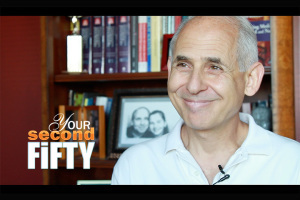 CYNTHIA: I agree with you that many people these days would rather see a movie or hear an audiobook than read a book, and I’ve been creating YouTube videos and audiobook editions of my books to meet this growing demand. I’ve also seen exactly what you’re describing regarding people around age 50 who either seem to be thriving or declining, with evident differences in ease of movement, involvement in learning and creative pursuits, and zest for life. I’ve also gotten the feeling we’re not doomed at age 50 to be “over the hill,” but actually can truly thrive. Have you personally experienced turning around a limiting belief about aging in your life, and if so, would you tell us about it?
CYNTHIA: I agree with you that many people these days would rather see a movie or hear an audiobook than read a book, and I’ve been creating YouTube videos and audiobook editions of my books to meet this growing demand. I’ve also seen exactly what you’re describing regarding people around age 50 who either seem to be thriving or declining, with evident differences in ease of movement, involvement in learning and creative pursuits, and zest for life. I’ve also gotten the feeling we’re not doomed at age 50 to be “over the hill,” but actually can truly thrive. Have you personally experienced turning around a limiting belief about aging in your life, and if so, would you tell us about it?
FRANK: When I was a kid I suffered from asthma, and while I played sports, I was always missing parts of seasons because my lungs couldn’t handle the training. When I was 52, I decided I was going to run a marathon. I was over weight and hadn’t done any exercise in years. I began slowly, just walking one or two kilometers. Three months in, I was up to a ten K run, and 6 months later I finished the Bangkok Marathon – 42 K in just over 4 hours. I didn’t need to win the race, I just needed to change my belief from I couldn’t run – to I can run – I will run and I will finish what I started.
CYNTHIA: Wow, what an inspirational experience! I’d not heard of the Bangkok Marathon before, and I’m truly impressed that you reached a point at age 52 where you noticed you’d gained weight and weren’t exercising, and so you looked around to find what could motivate you to become more physically active. I’m sure your ability to set an athletic goal for yourself must have been made a bit easier thanks to your having played sports earlier in life. What advice would you give someone in their second fifty years who wants to get more exercise but hasn’t played sports?
FRANK: When we started to make the documentary, I seriously thought I needed to interview one of the worlds top fitness guru’s, but over time I’ve realized that it’s not about having the body of a Greek goddess. It’s about being fit from the inside out. Going for a 30 minute walk each day not only improves your fitness level, but it’s beneficial, mentally, emotionally and spiritually, and when we are more fit in those four areas of our life, we’ll attract more opportunities financially. But there are three other areas of physical wellbeing we need to consider:
1) Flexibility – a little stretching daily will pay incredible dividend down the road in our 80′s, 90′s and more and more likely our 100′s,
2) Resistance training – we need to keep our muscle in shape to support our physical structure so our later years are positive and product and
3) What we eat – as we get older the metabolism slows down because we slow down, so eat more fresh, raw foods and most importantly eat less–and that’s hard to do if we’re sitting on a couch.
CYNTHIA: I love the way these are simple things most people can do by making small adjustments to daily life. I can also reassure people that your advice is quite sound, as it’s coincidentally what I’ve been doing for the past 15 years since I took up practicing martial arts when I approached the age of 40. I’m doing the flexibility and resistance training as part of my Kuk Sool Won practice, and being much more mindful of what I eat, and I look and feel so much healthier now than I was 15 years ago. These tips are pretty well-known, but I understand your movie, “Your Second Fifty” does some pretty serious myth-busting concerning typical ideas most people have about aging. Could you share with us one of those myths you address?
FRANK: Honestly that’s the great part about the documentary and the sad thing when you take a minute to consider just how many limiting beliefs impact us after 50. And even when we’re aware of these limiting beliefs, we have no idea how to address them and remove them. But you wanted one, so let’s consider memory loss. We had the opportunity to interview Dr. Daniel Amen, possibly North America’s leading expert pertaining to the Mental Dimension. Without giving away all the goods here, he alluded to the fact that memory loss can be caused from a number of things–none of which were age-related. Having received a head injury as a young child that had gone unattended, or an inactive life style, both mentally and physically are far more likely to be key determining factors for memory loss in people over 50.
CYNTHIA: So if I understand you correctly, there’s no need for people to assume we’re all headed for dementia as we pass the ages of 50, 60, 70, and 80… nor is there any reason to presume we’ll necessarily be less active or less physically fit in our second fifty years of life. And hopefully, good results are obtainable in terms of improved quality and quantity of life without needing to spend a fortune, right?
FRANK: Well, let’s adjust that a bit – there is no need to assume we’re all headed for dementia – IF – we make the changes. If we don’t, then we’re rolling the dice, because the majority of people have sustained some form of head injury, or currently maintain a sedentary lifestyle. You just have to know what to do to make the changes! As far as fitness goes, one of the gentlemen we interviewed was Werner Berger. Last year, Werner climbed the highest peaks on all 7 continents (which by the way included Mt. Everest). Werner is 76 years of age. It’s also important to state that at age 59, Werner decided to climb mountains, so he is no different than anyone reading this article. That’s what makes this documentary so important – it will change the way we have been programmed to age. It may be the best investment anyone can make with regard to their longevity and wellbeing. Life is best served when we challenge ourself to be the best we can be, and give up competing with others.
CYNTHIA: Based on what I’m hearing from you about your new documentary, “Your Second Fifty,” and what I’ve learned from the latest research, I’m thrilled that you’re making this movie, and so glad that there will be such an inspirational film people can sit down and watch that has the power to so thoroughly improve peoples’ lives. If people are interested in finding out more about the movie, what’s the best web page for them to learn more?
FRANK: Thanks Cynthia! Our website is www.yoursecondfiftydocumentary.com. If people wish to secure a streaming of the documentary they can go to our Indiegogo campaign and select Perk #2 and for that $5 give themselves every chance to live their remaining years healthy and happy – one less fancy coffee and they’ll change their life forever. https://www.indiegogo.com/projects/your-second-fifty-documentary–2 Our planned premier with be held in Los Angeles November 15th. Thank you and keep smiling!
CYNTHIA: Thank you, Frank! I so appreciate your taking the time to answer my questions and share so much valuable, life-changing information with us today!



July 1, 2014
Top Ten Ways to Shift Reality and Quantum Jump
Our thoughts and feelings change the world around us, whether we’re aware of it or not. We get lots of little clues this is happening when we pay attention; we’ve all had days when we can’t find our car keys because they aren’t where we know we put them, or we discover one sock is missing from our load of clothing that just came out of the dryer. At times like these, it can feel like “Shift Happens! #@$! “
The good news is that we don’t need to suffer from discordant thoughts and feelings! We can learn how to minimize the frustrating reality shifts, and learn to make our favorite dreams come true.
1. Pay Attention
The world seems full of whatever we focus our attention on. When you’re thinking of buying a new car, you see the kind of car you’re thinking of almost everywhere you go. Be sure to start looking for evidence that indicates your wishes and prayers are being answered. Seeing the world with a Zen “beginner’s mind” is the key to paying attention properly in this present moment, right here, right now. Meditating daily helps you make time each day to quiet inner self talk and become increasingly mindful and attentive.
2. Appreciate
Being grateful for what we have is the best way to receive more of what we most enjoy. Expressing appreciation and thanks feels good and helps us continue to pay attention to what we most love, allowing more good experiences to come our way. When making a few moments each day to review what you’re grateful for, be sure to truly feel thankful as an emotion that builds and increases inside you with every breath you take.
3. Review the Scientific Studies
Reproducible, double-blind scientific studies conducted by doctors in real-life hospital situations are now proving that distant healing through prayer and meditation improves the health of those being prayed for. The wishes and prayers have come from people with a wide range of beliefs, indicating that we are all non-locally connected and can influence physical reality from great distances.
4. Revise Your Assumptions
The old assumptions that we can be objective observers without influencing what we’re watching or having any long-distance effects have been scientifically disproved with recent quantum physics experiments. We now know that we can only make predictions in terms of probabilities, and that we can’t disregard consciousness or spirit simply because we can’t measure those things. Many of our views of who we are and how we ought to live can change in very positive ways as we take time for reflection, meditation, and reviewing what we believe to be true about ourselves and the multiverse we live in.
5. Energize Yourself
Take a few minutes to reverse the damage stress causes to your body every day. Breathe love in, feeling it in your heart, and recall some of your favorite memories. These feelings of Love will energize you tremendously, which increases the probability that you will experience enjoyable reality shifts. You can dowse your energy field and the energy fields around others to see how energized people are using dowsing rods, metal coat hangers, or even your hands.
6. Reverse Negative Self-Talk
Our inner self-talk is a running dialogue with the universe. When self-talk consists of put-downs and negativity, it directly interferes with anything good we wish to observe. We can minimize negative self-talk by first quieting the mind in order to hear what kinds of self talk are going on, and then “flipping” each negative statement we notice around, making positive affirmations out of reversed statements. Posting these affirmations and reading them every day is a powerful way to remove the destructive interference with personalized affirmations.
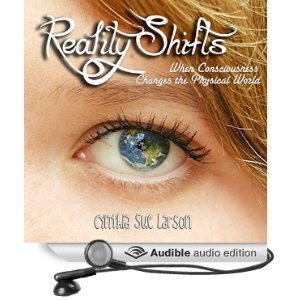
Reality Shifts is now available as an audiobook!
7. Feel Non-Locally Interconnected
Just as quantum particles are found to be intimately interconnected with twin particles located great distances away, we also are non-locally interconnected with everything and everyone we love. Though you may sometimes feel lonely, the truth is that you are never alone, isolated, or cut off from everyone. You are connected with everyone and everything else in the multiverse that you affect All That Is.
8. Visualize What You Desire
Visualize what you most desire to experience in your life–all your favorite, wildest dreams–with the idea in mind that we actually create reality as we observe it. As we think and feel, so we become. One of the best ways to see wishes come true is to visualize and feel them clearly with all your heart, and then let them go, much as Jane and Michael Banks, the children in the movie “Mary Poppins,” do after singing a poem about what they wish for in a nanny.
9. Let Go of Wishes
The best way to make our favorite dreams come true after we’ve visualized them is to release them. This gives them the degrees of freedom required to exist unobserved as pure energy waves, before our observation collapses the wave functions and one possibility materializes. Returning to the example of making wishes from the movie, “Mary Poppins,” Jane and Michael Banks’ father throws their wish list of qualities into the fireplace, representing the necessary step of letting go–which floats up the chimney to the clouds where Mary Poppins finds and responds to it.
10. Choose Your Attitude
The most important thing to remember when you face challenges or seemingly impossible situations is to remember that reality can shift! You can choose to replace your feelings of stress, fear, or anger and breathe Love. Choose to let the wise, timeless part of you do the thinking… from your heart. The more you practice this meditation of “thinking with your heart,” the easier it will be, and the more wonderful reality shifts you’ll experience!
The video version of this blog post can be found on YouTube at: http://youtu.be/KHhhpxtoC0k


June 6, 2014
The Power of Attention: Fine-Tuning Our Focus
 I noted on a morning walk this month while walking our family dog on a route we have been taking quite often on our daily walks over the last several years, we passed a house marked with a whimsical sign:”Place Trilling.”
I noted on a morning walk this month while walking our family dog on a route we have been taking quite often on our daily walks over the last several years, we passed a house marked with a whimsical sign:”Place Trilling.”
Though I’d seen this same sign and this same house day after day for many years, on this particular day the thought occurred to me that this might be the house of my favorite UC Berkeley physics professor, Professor Trilling. I imagined how nice it would be to see Professor Trilling again, and that it would be especially wonderful to get to say “Hello!” and tell him how well I remember him and his wonderful physics classes at UC Berkeley after all these years. It’s well worth mentioning that I was in a meditative state when these thoughts occurred to me, as I often meditate while I walk, and on this day I was in a particularly blissfully meditative state of mind.

our dog
The very next day, while walking our dog along the same route and past the same house, I saw an elderly gentleman assisted by a middle-aged man getting into a car. As I walked past, I thought about interrupting to inquire whether this was the Trilling I’d studied physics with some three decades ago, but couldn’t bring myself to interrupt them. I would have kept on walking, but my dog stopped abruptly in his tracks, completely transfixed by a goat sculpture he saw standing in the car port next door.
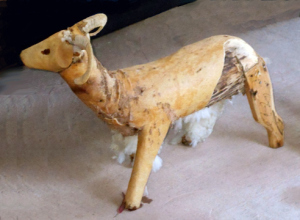
intriguing goat sculpture
Our dog loves goats, but I’d never seen him so captivated and enthralled by any piece of artwork before! In the moments that passed, he pulled vigorously toward the life-sized wooden goat sculpture, complete with its tattered wool coat and beautifully carved wooden horns. Thanks to this interruption in our walk, a few moments later I realized I had the opening I needed to introduce myself to the middle-aged man, who had finished helping Professor Trilling into the front seat, so I tugged my dog along with me on his leash over toward their car.

Professor Trilling
“Excuse me,” I said, “Is this Professor Trilling? I was a student of his at UC Berkeley in the 1980s, and he was a favorite professor of mine!” The man looked surprised at first, then nodded and said, “Yes he is.” I proceeded to tell him how much I loved Professor Trilling’s classes, and that he was my favorite physics professor at UC Berkeley, and the man suggested I tell Professor Trilling myself. I replied that I didn’t want to bother him, but the man replied, “He’ll be happy to hear from you!” So I walked up to the car and spoke to Professor Trilling directly, telling him how much his classes meant to me, and that I’d never forgotten him or his wonderful teaching after all these years.
The significance of this sequence of remarkable events of:
(1) finding out that this indeed was the home of professor Trilling,
(2) getting a chance to know whether professor Trilling is still alive and well, and
(3) having the opportunity to thank professor Trilling in person for being one of my favorite physics professors at UC Berkeley.
The fact that all this came about thanks to my being stopped by our dog’s fascination with goats at just the right place and time to provide the perfect opportunity to introduce myself was not lost on me. Thanks to his focused attention on something of tremendous interest to him (goats), I was able to experience something of great meaning to me that I was focused on (professor Trilling).
Experiencing these kinds of coincidences between what I pay attention to and how subsequent events unfold can at times like these be so precisely tuned when I’m in meditative states as I am during my walks, that I have a vibrant sense of living in a waking dream… or what’s known as “lucid living” as described in Reality Shifts: When Consciousness Changes the Physical World. For me, being in a meditative state is akin to letting go of feeling attached to any particular reality while being fully present and open to experiencing what is right here, right now. In my walking meditations, I am often in a state of feeling blissfully unconcerned about worries about the future, regrets about the past, or any other emotional baggage or “stuff.” Time and time again, whatever I think about and feel strongly about in such a state of consciousness comes into being. This is a special way of paying attention to myself and those I care most about, including my dog and his love for goats, and the possibility of reconnecting with a favorite professor.
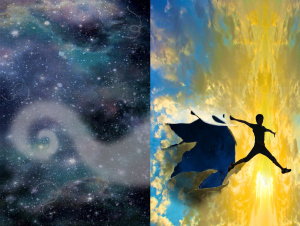
“Quantum Jumps” front and back cover art
Fine-tuning our focus of attention thus becomes a skill of remarkable influence and meaning, as the seemingly simple act of focusing awareness is capable of making connections through vast unseen realms, across multitudes of parallel worlds of possibility. From our vantage point, the world still appears “normal,” and life goes on… yet at some point in the near future, chances are very good we’ll see evidence of the direction we chose to focus on just now. At such times, we might be witnessing evidence that we live in a holographic multiverse, which is not the multiverse you may have heard of in which each parallel universe is completely separate from all others, but instead is a multiverse of interconnected possibilities. To be alive in such a multiverse is in some very real sense to be aware of other possible me’s and other possible you’s… to have a sense of imagination that we might be happier, healthier, or more creatively involved, for example, than we currently are…. and that we can make quantum jumps to those realities.
These kinds of jumps are part of our everyday normal experience of life in a reality that is primarily quantum in nature… though what we often speak about being most real is the material reality of classical physics… until such time as we remember some of the most important “things” aren’t things at all. Love is one of those completely unmeasurable “things” that has no part in classical material physics, just as consciousness is not considered necessary either. Though anyone who has ever fallen in love, had a child, or experienced the death of a loved one will surely agree that a scientific explanation for reality that does not include such things is obviously incomplete.
The video version of this blog post can be found on YouTube at: http://youtu.be/Ej-sKdvm3mo


May 8, 2014
Cynthia Sue Larson Interviews Alexis Brooks
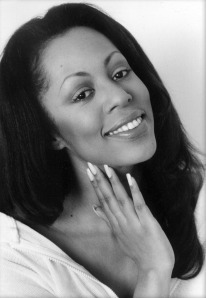
I met author Alexis Brooks for the first time in person just the other week in the San Francisco bay area at the New Living Expo. We’ve been good friends and colleagues for more than ten years, but this was the first time we managed to be in the same place at the same time. What a treat!
What’s impressed me the most about Alexis over all these years is her consistently positive outlook, and deep wisdom regarding metaphysical matters. Alexis is one of those inspirational people who are as beautiful inside as as out, so it’s no surprise that even regular snapshots of Alexis shine with inner light!
I’m deeply grateful that Alexis granted me this interview where she shares some fascinating insights into her background and interests. Even though I’ve know Alexis for years, I loved getting the opportunity to learn more about why she has such a passion to share powerful insights about consciousness and metaphysics with the world, and where this lifelong interest began.Alexis recently published the #1 best-selling book, Conscious Musings, and she is the featured writer and host of The Conscious Inquiry Radio Show at Conscious Life News.
______________________
CYNTHIA: I’m just tickled pink to do this interview with you, since I have been so inspired by your writing and your work for so many years! You have such a refreshingly light yet simultaneously emotionally soulful approach to sharing ideas that empower people to see themselves and the world in a whole new way. What would you say was your primary inspiration to do what you do today?
ALEXIS: Thank you Cynthia. First let me say what a pleasure and an honor it is to be interviewed by you. I too have admired all that you’ve done over the years to bring so many individuals to a place of understanding about the magnificent workings of reality – how vast it is and how we can all participate in our own personal reality shifts…kudos!
As for the inspiration for the work that I do, I’d have to say that the influence started very early on for me. I grew up in what I’d call “an alternative home.” Although my parents were very much immersed in the mainstream – my mom was an educator and my dad a scientist (self taught) from M.I.T.–both very “left brained” professions, somehow they naturally gravitated toward the BIG questions of life, you know, “Who are we?” “What are we capable of?” and “How does reality really work?” They’d sit around the kitchen table and discuss things like reincarnation, extraterrestrial life, life after death and spirituality in general, including much of the teachings of the various “orthodox religions.” When I was old enough to pull up a seat to the table, they would include me in discussions, welcome my curiosity AND my opinions. When they decided to embark upon learning transcendental meditation (TM), they brought me along to class too–at the age of 13! It was a family affair. So I was indoctrinated, you might say, at a very young age.
But then my natural curiosity took on a life of its own. I found myself genuinely interested in these same big questions, wanted to explore for myself, and I did. I found myself somehow grasping concepts that even my parents couldn’t fathom. I remember having this epiphany one day about the nature of time. I must have been reading something about the illusory nature of time, how linear time is a physical construct and that in actuality all time is simultaneous. I don’t know how, but I just seemed to “get it.” I remember talking to my mother about this newly found realization with such enthusiasm–I remember her saying to me, “Now THAT’s over my head…” I didn’t understand how she didn’t get it and I did. I guess I went on my own trajectory from there.
What’s also driven this natural interest in me is that I would occasionally have my own let’s just say, “curious” experiences–pre-cognitive dreams primarily. I knew SOMETHING was going on; that it was important, and I felt that most people just weren’t getting the true nature of reality–that there was so much more, and I was determined to investigate these underpinnings. As I grew, I became more voracious in my studies–branching off into all sorts of areas of metaphysical study. Although I didn’t realize quite where this would be headed. I’ve had several what I like to tell people “incarnations” in this life–worked in various industries, including entertainment (I was a teen model and bit actress), broadcasting, marketing and small business ownership. I’ve had several different careers but this work is without question my passion. I wouldn’t have it any other way. I simply love what I do and I’m so blessed to be able to do it!
CYNTHIA: I love how thanks to growing up in a family with such intelligent, spiritually-minded parents, you instantly grasped the idea of simultaneity of time! This kind of notion is one that reminds me of holism–of a view that I see is emergent right now in the realm of quantum physics at a time when dualism and material realism is still the dominant paradigm. This is a time when many people who are aware of a deeper interconnectedness would love to know how best to share this realization with those who don’t yet “get it.” What would you say to people who are starting to wonder whether the old classical perspective is incomplete, or how such “things” as non-dualism or simultaneity of all time could possibly be?
ALEXIS: Well right off the bat this is a difficult concept to get ones heads around (this notion of simultaneous time). As I said, my mother, whom I looked up to for her sense of exploration into the “unknown” was absolutely dumbfounded when I presented her with this possibility, so consider that. And she was a “big seeker.” You take the everyday person and present such a concept and chances are they’d think you were crazy. Simply put–this is not the type of discussion you can have with anyone (unfortunately). As much as I’d like to wave a magic wand and say, “You will now GET IT.” That’s just not going to happen. In fact, I’ve stopped trying to convince certain people of the efficacy of such matters. I’d once heard, “We must leave people to their own pace of learning as part of their own path in this incarnation and not be so keen to judge it…” Something like that. That made me take notice. As much as I’d like to argue the merits of this theory of simultaneous time and how we can present all sorts of data (and experience) to show its empirical evidence, I can’t. I think the actuality of this concept will present itself to those who are ready to receive it.
Here’s a very basic idea that I’ve often contemplated…Isn’t it interesting how man constructs, plans, calculates the slight tilt of time by changing the clock one hour forward in the spring (“spring forward”) and one hour back in the fall (“fall back”). This is the man-made manipulation of time. This is not a perennial process but an annual process. One that man decides. That always intrigued me and struck me as curious. How is it that an edict can be made to say we will fall back one hour or spring forward one hour and all are expected to abide by it? Our bodies and our minds obey this edict. This isn’t fundamental time, this is constructed time. And yet we abide by its laws. This was a curious clue to me many years ago–it told me how “plastic” time is and how mutable time is….this was a clue to me as to the malleability of time. It’s just not what we think it is. Therefore, it is far more plausible to me that time at its fundamental core IS simultaneous. How is it that we can have “pre” cognitive experiences (dreams, insights, waking visions) when time is supposed to be linear? The answer: it’s not! This is probably what tipped me off to the reality of the simultaneity of time, and this is what I’d encourage others to explore when asking themselves these BIG questions.
Now, as to how to “convince” others of this reality, especially those (as you said) who are wondering whether the old perspective is incomplete. The good news is that those who are wondering to begin with, probably already have a clue that the old model is incomplete! This is an innate knowing. Something within the core of our being already knows these things – feels it, in fact. It’s just difficult to articulate it. So that’s why it’s so important to be around others who are willing to discuss these ideas, muse about the process of non-linear time (no-time) and other fantastical ideas like these. Good news–we’re getting there–slowly but surely. I don’t know–maybe our DNA is finally waking up, along with our consciousness. I’ve always felt that there is some faculty built into us that inherently knows these things and always has. These faculties have become dormant; atrophied. But somehow, we’re being nudged to wake up (by the Universal Alarm Clock, LOL)! That’s what my book is really all about–waking up these dormant faculties. The understanding of simultaneous time is just one mechanism to do just that!
CYNTHIA: This really does feel like a special time in history unfolding right now, doesn’t it? And speaking of clocks and time, I hear from lots of people who notice things like seeing 1:11, 2:22, 11:11 and so forth on digital clocks, getting a sense that it’s time to wake up. How long have you been aware that we are entering a time of awakening, and how were you called to be of service?
ALEXIS: There’s no question that we’re living in an unprecedented period of history. Some feel that we are here during the “end times,” and others are truly excited to be here during what many feel is this incredible shift in human and even Universal consciousness. I am one of those people in the latter category! My “entry point” into what I’d call awareness of this shift occurred during a personal experience that lasted three months back in 2005. It was an out of this world experience. It just descended on me with no warning and no cajoling on my part–it just happened! Some have described it as a “kundalini awakening.” I’m not sure if that’s what it was but I have to tell you it was a breakthrough the likes I’ve never experienced before. To this day I feel honored that I came upon this confluence of physical, psychic and cosmic reality, although I don’t know how it all happened. It’s a long story and one that I’m still trying to fully comprehend to this day! I was “given” information about “the future,” about the important times ahead. Admittedly at the time, I’d little to no knowledge about prophecies like the Mayans or Hopis – 2012, et al…none! But I got this sense that whatever I’d be doing in time would be instrumental in helping humanity (along with others) through this period. It was then that I began seeing 11 on the clock…1:11, 3:11, 5:11, 11:11, etc. I didn’t know what to make of it. Not too many people were reporting such things back then, but look at the number of inquiries these days.
When you Google “I see 11:11” you’ll get roughly 275,000,000 results!
That’s a lot of people either seeing 11:11 or wanting to know its significance. That’s huge! Something quite powerful is going on. I wish I could say with absolute certainty what it means, but I cannot. After contemplating the significance of the “11” phenomenon, my sense is that it carries multiple meanings, applicable at different times. It might act as a warning at one time and a wink and a nod at another. I think the observer must derive the synchronistic significance for themselves. Either way, I sense that we are being ushered in to a new way of thinking and a new language and perhaps numbers are becoming a central communication tool for us all. Pretty fascinating!
CYNTHIA: I share your optimism about these special times, and an associated sense of excitement and importance about this time in history. I also can’t help but wonder if perhaps the reason you and I both tend toward optimism about the future might in some way be related to both of us having gone through kundalini awakening experiences. I like the way you point out the way increasing numbers of people are noticing 11 on the clock, as well as other types of repeating numbers such as 2:22, 3:33, and so forth. These are patterns I began observing immediately upon my kundalini awakening. Given that people who see such numbers might literally be receiving a kind of cosmic “wake up!” message, how would you advise people to stay awake, rather than hitting the “snooze button” and drifting back into living on autopilot?
ALEXIS: First I want to address a key point. I know we have to stay optimistic, but allow me to make clear something that I feel to be quite important. I’ve said many times that in order to “go with the shift” we also have to acknowledge both the shadow and the light – they are equally important. The alchemists of old new this “secret” and they utilized it quite effectively in order to transform themselves and their reality. So many are focused on just the light and the positive and that’s great, but there’s something quite powerful about understanding the shadow effect as well. We all have it, we embody it, and we have the ability to transcend it, but only if we recognize it. I love this quote by author and philosopher Neil Kramer whom I mention in my book who said, “To get to the real thing, it is necessary to first stop everything. Everything! Only by holding still can we go deep beneath the calm of the surface and actually look into the darkness. Whatever is there is you. Blemishes, conquests, beauty, mortification, bafflement, and longing–all of it has to be first seen as just what it is.” So as much as I’d like to only acknowledge the path of positivity during these special times, I don’t want to make the mistake of ignoring all the dimensions it comes with, including the shadow. As I’ve said, when we can acknowledge the darkness, we will be quicker to eradicate it. That said, I think people are certainly starting to recognize all the quirky, non-linear, bizarre patterns they are being presented with these days, not the least of which are numbers. We’ve talked about the “11” phenomenon and other numerical patterns that seem to be in our face. There are messages implicit in these numbers. These are not easy to distill, but if we can use something I have coined, called “subtle acuity”–the ability to hone our gaze and be hypersensitive to our surroundings and all of the cues the Universe gives us to guide us (including numbers), we will become more attuned to universal language and more primed to shift and evolve.
As you’ve mentioned, staying awake is absolutely necessary. Nothing less will do. All bets are off as far as hitting the “snooze button’ is concerned! It’s easy to fall back asleep when we have so many prompts to ensure we do so, like media and technology and well, the “hamster wheel.” But we can’t relent. We must stay awake and aware. Our survival and thrive-all depends on it!
CYNTHIA: Might another way for people to consider accepting their shadow sides be through becoming more compassionate–loving and accepting all aspects of themselves? I ask, because it seems so often in the news these days we hear that people who’ve been the loudest in advocating separatism of one kind or another turn out to secretly have been concealing aspects of themselves they felt others couldn’t… or wouldn’t… accept. Would you agree that being more loving, accepting and compassionate toward oneself can help each of us be the change we wish to see in the world, and if so, would you please share tips or suggestions to help people with this?
ALEXIS: Absolutely! I’ve no doubt that becoming a loving and compassionate individual will be a major step in transformation, but I want to elucidate one crucial element. Let me do it with another illustration. Some years ago, alternative historian and author Graham Hancock told of this stunning experience he had while journeying I think to Brazil where he had a shamanic experience that involved the use of the native plant ayahuasca. During the partaking of this hallucinogen which culminated in an altered state of consciousness, he found himself confronted with a great beast that looked to have the head of a crocodile and the body of a human. The beast was overwhelming and frightening. Hancock had to confront the being, but eventually something told him to look the beast in the eyes with all of his heart and when he did, the beast simply dissolved. (I’m sure I don’t have the details of the story exact but hopefully you’ll get the idea.) Bottom line, the moment he confronted the beast, it dissolved and when that happened, all of reality shifted for him. The lesson is that when you confront the “beast” you can truly embrace compassion and be loving and accepting of yourself and your life. Actually, I don’t think it can happen any other way. I have a sneaking suspicion that what we fear most is merely illusion and the moment we confront the illusion, we dissolve it and when we can dissolve it, we can truly arrive at a place of compassion and love of ourselves and of others. That’s absolutely powerful!
Clearly I wouldn’t advocate seeking out an experience of this magnitude in order to come to a place of compassion. I think we can achieve this in other ways. First and foremost, we must forgive ourselves on all fronts (and forgive others). We must realize that blame is a futile endeavor. Let’s just get on with what is true in our hearts (and I believe at the core, it is simply LOVE). Second, we must not take the external or epidermis layer of reality too seriously. As the late great Michael Talbot once said, “We are like iceberg beings–most of us is beneath the surface.” Let’s commit to investigating beneath the surface to uncover the true gifts of ourselves and when we do we can finally embrace them! Finally, we must awaken what has become dormant in our consciousness and that is the idea that we are absolutely powerful, creative and limitless beings. I know this may sound cliché, but once we unravel the layers of belief that have told us otherwise, we can have our own personal epiphany and finally breathe a sigh of relief and rejoice and truly live inside our personal and collective power.
CYNTHIA: You have such a wealth of personal experience with learning to come to a place of compassion, and experiencing a real sense of forgiveness and inner limitless power. Some people can become so fixated on what went wrong, and who’s responsible for creating the problem, that forgiveness and compassion can seem impossible. What “baby steps” tips can you suggest for someone who finds it hard to access a place of deep compassion and forgiveness?
ALEXIS: The act of forgiveness can be a difficult thing for so many people. Particularly those who were wronged in a big way, say emotional or physical abuse of some kind. I wish I had a magic set of words I could convey to provide the answer. I don’t know that there are words that can be said, but rather a feeling that needs to be embodied by each individual seeking to find a place of compassion and forgiveness but are getting stuck.
Here’s one suggestion I can lend. Let’s say you are suffering due to a sense of blaming another and you can’t get to a place of forgiveness. A little exercise you might do is to go outside, preferably a place that is in nature and is quiet, say beside a tree. Stand with both feet firmly placed on the ground, barefoot if possible. Begin to recall the act or experience that made you so angry – something that someone did to you, or maybe it is something that you inflicted upon yourself. FEEL that anger, sadness, blame as much as you can–really feel it! Bring up that emotion from the core of your being. NOW, imagine taking all of that condensed energy – that anger, sadness, etc, and moving it through your body, downward until it empties out through your feet. Imagine all of that energy washing out of you and into the ground, like muddy water being absorbed by a porous section of soil. Really imagine this happening. Then ask the earth to take it unto herself and transmute it–literally shifting the energy from negative to positive. This is a very alchemical process. You can also imagine this energy as being old scraps of food that has turned into unusable waste. The earth has the ability to compost that energy and turn it into fertile soil, ready to be planted with new thoughts and new emotions. Now it’s ready to receive a space of compassion and forgiveness and so can you. I’ve always looked at nature as one of our best teachers. When you simply observe how nature works–it’s cyclical process, its effortless ability to produce and multiply AND its ability to take unusable “negative” waste and change it into fertile soil, ready to be planted with new seeds, you have to ask yourself am I not made of the same characteristics? I think we are. And the more we can work in harmony with nature, the more it will support us. I think this is more than a metaphor. We have all the tools we need to access a place of forgiveness, compassion and joy and nature is one of our greatest allies in this process!
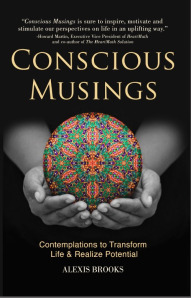 CYNTHIA: I agree with you that Nature is a great teacher, and I love the natural sense of harmonious energy I can feel when standing, sitting, or lying on the ground outdoors. I’ve seen people who had been feeling emotionally distraught quickly attain a sense of peace and calm, simply from sitting or lying down on the grass… and I’ve heard of people who say they’ve been healed by the Earth simply by lying down outdoors on the ground. Part of this may have to do with the healing natural Schumann frequency of about 7.8 Hz, and part may be due to hearing natural sounds of wind, trees, and birds and seeing natural beauty. And speaking of beauty, I must say your new book, Conscious Musings, is gorgeous! Did you have something special in mind when designing the cover for your wonderful new book?
CYNTHIA: I agree with you that Nature is a great teacher, and I love the natural sense of harmonious energy I can feel when standing, sitting, or lying on the ground outdoors. I’ve seen people who had been feeling emotionally distraught quickly attain a sense of peace and calm, simply from sitting or lying down on the grass… and I’ve heard of people who say they’ve been healed by the Earth simply by lying down outdoors on the ground. Part of this may have to do with the healing natural Schumann frequency of about 7.8 Hz, and part may be due to hearing natural sounds of wind, trees, and birds and seeing natural beauty. And speaking of beauty, I must say your new book, Conscious Musings, is gorgeous! Did you have something special in mind when designing the cover for your wonderful new book?
ALEXIS: I was so blessed to have a fantastic team bring my concept to life for the cover of Conscious Musings. I’ve always felt connected to the idea of the mandala and particularly Dr. Carl Jung’s interpretation of the mandala and its spiritual significance. When I had my web site some years ago, I chose to feature a variety of mandalas as part of the theme. So when I decided on a book cover concept, it was a “no brainer” for me. It had to include the mandala, but I wanted to give it more of a three-dimensional feel and I wanted it to appear as if this omnipotent, omniscient source of consciousness would be accessible to all. So I portrayed the mandala as being presented to every reader as an opportunity to partake in its gifts which are in truth our own innate gifts. In fact at the end of the book, I conclude with a short message that is meant to convey the cover’s significance. It goes like this:
“Out of the dark abyss, there emerged a pair of outstretched hands. Gently moving toward me, I squinted, blinded by the hazy light that surrounded its shape, I knew not what it wanted with me.
I could not move. I could not speak. My eyes became affixed to what materialized in its gentle palms. The hands came closer, cradling its contents.
There it was – the sphere of life, the nucleus that I had been missing from for so long. Its vibrant colors and intricate shapes penetrated my being with a purpose that I could no longer ignore. I had a vivid remembrance that this was once me.
Now it is being returned to me with the promise of transformation.
This time, I shall partake in its promise and never look back.
This time I will accept what these hands offer, the promise of me–as I was meant to be!”
My sincerest hope is that the cover and most importantly, the contents of Conscious Musings will convey this message to each and every reader–that it is our divine right to embrace our own sense of self, that knowledge and wisdom and love lie within, and that the Universe is beckoning us to re-awaken these qualities for the positive transformation of ourselves and our world. Life is a gift and if we recognize it as such we will be so much closer to realizing the absolutely creative and limitless beings that we truly are!
CYNTHIA: That is so beautiful! It gives me goosebumps of happiness and joy! Thank you so much for taking the time to share so much wisdom and inspiration both in your marvelous book, Conscious Musings, and also in answering these questions today. Would you please be so kind as to let people know how they can best learn more about you and your work?
ALEXIS: Sure, and thank you so much for warmly extending the opportunity to spend some time with you Cynthia! My “home base” can be found at: www.higherjourneys.com. You can find details of my book Conscious Musings there as well as a regularly updated blog of my latest musings on metaphysics, paranormal, and all sorts of reality transcending information. My radio program, Conscious Inquiry with Alexis Brooks can be found at: http://radio.consciouslifenews.com/shows/conscious-inquiry. If you’ll allow me to borrow your signature question…“How good can it get?” My answer–REALLY good! Thanks Cynthia!
CYNTHIA: Thank you, Alexis! I’m so grateful to you for taking the time to answer these questions and share so many fascinating insights with us today!



May 6, 2014
Learn How to Dowse with Wire Coat Hangers
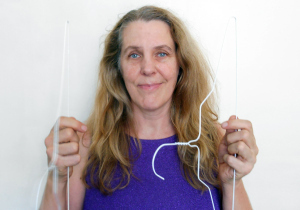 In just a few minutes, you can learn how to dowse with wire coat hangers. The first thing you will need is to get one one or two wire coat hangers. If you’ve got two wire coat hangers, this works a little bit better.
In just a few minutes, you can learn how to dowse with wire coat hangers. The first thing you will need is to get one one or two wire coat hangers. If you’ve got two wire coat hangers, this works a little bit better.
Secondly, you want to hold them this direction, so that your hand is on the flat bar, one hand on each. What you are doing is you are allowing these hangers to swing freely like this. You can see them swing one way, than the other. That means you’re not gripping too tightly. You want to hold on loosely, and keep the wire straight up and down.
And the third thing is you want to focus your attention on what it is that you are looking for. This means that for each time you are dowsing, it is essential that you maintain a clear and undistracted mental focus of attention on whether you are looking for subterranean water, ley lines, or human energy fields.
I learned how to dowse in the town of Royston, England, where the curator of the museum showed me that I could find both the energy lines–the male and female energy lines under the museum called the Michael and Mary ley lines, and I could also refocus my attention and look for water, finding water under the cobblestones in the courtyard. It was really amazing to me because it works so easily.
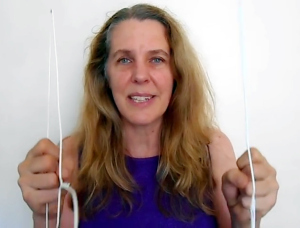
So here’s how you do it. Hold on to your coat hangers, making sure that you get the feeling that they can move freely, so you know you are not gripping the hangers too tightly. Make sure that you are holding them straight up and down, with both of them in hand.
Thirdly, once you’re holding them straight up and down, and they are in position–focus your attention. So if you’re looking for something such as water lines under your property, you can move around walking with these. They will be swaying as you walk, like that. That is very normal. When you hit the edge of water, if that’s what you’re looking for, you will get a response where the hangers swing together, or they might swing open.
As you cross across that water to the other side, then your hangers will go back to this swing again, and they will be swinging left and right with each step, pretty much. And that tells you are doing this very nicely. Other things you can dowse for as I describe in my book, Aura Advantage, is that you can also dowse for energy fields of the people around you: your family, your friends. You can also dowse the energy field of plants and so forth.
Why does this work? As I describe in my book, Quantum Jumps, this is basically one of the many quantum phenomena that we are increasingly noticing in this Quantum Age, in this case entanglement. You’re able to put your focus of attention on something that you can actually sense remotely and get a response with, because you’re entangled with it.
Have fun with dowsing!
The video version of this blog post can be found on YouTube at: http://youtu.be/SLk-WO6E0us


Learn How to Muscle Test in Minutes
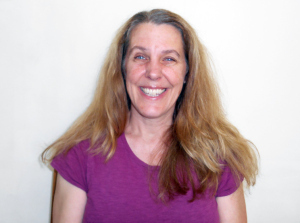 Muscle testing is a wonderfully simple technique that you can use just about anywhere you go to tap into intuitive information we all have access to. You might notice sometimes you have gut feelings about whether a choice you’re contemplating will work out well for you or not, and if you’d like to find a way to better hear that “still, small voice,” muscle testing is a wonderful thing you can learn to do in just a few minutes that can provide you with intuitive information very quickly in almost any situation, any time, anywhere.
Muscle testing is a wonderfully simple technique that you can use just about anywhere you go to tap into intuitive information we all have access to. You might notice sometimes you have gut feelings about whether a choice you’re contemplating will work out well for you or not, and if you’d like to find a way to better hear that “still, small voice,” muscle testing is a wonderful thing you can learn to do in just a few minutes that can provide you with intuitive information very quickly in almost any situation, any time, anywhere.
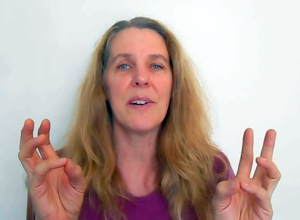 This type of muscle testing is a one-person technique that requires you have both hands free. You start by putting your fingers together so both hands are making little circles between thumbs and the pinky fingers. What you’re doing is creating something like a daisy chain when you put the two links together, intersecting the circle you’ve just made with your left hand and the circle you’ve just made with your right hand.
This type of muscle testing is a one-person technique that requires you have both hands free. You start by putting your fingers together so both hands are making little circles between thumbs and the pinky fingers. What you’re doing is creating something like a daisy chain when you put the two links together, intersecting the circle you’ve just made with your left hand and the circle you’ve just made with your right hand.
You can actually make these circles using your thumb on each hand with any other finger you like–but I suggest using your pinky finger, because usually it’s one of the weakest fingers. The advantage of weakness is that for muscle testing, we want some minimal resistance, but not too much.
Once you’ve made finger circles with both hands and they intersect like two chains in a daisy chain, the next thing you do is ask a question that you already know the answer to. For example, I would ask myself, “Am I Cynthia Sue Larson?” and pull my daisy chain rings apart–and they hold together very firmly. I’m not really trying to do this, I’m just focusing on, “Am I Cynthia Sue Larson?” This is my “Yes” when the chain does not pull apart.
Now that I’ve seen what a “Yes” looks like, I can ask a question such as, “Is my name John?” and I pull the chain apart. I’m once again not TRYING to do this at all, it’s just a weakness in the muscle, so that’s why they call this “muscle testing.” It is a form of dowsing. The reason behind it has a lot to do with physics, actually, and the fact that when you ask a question, you are essentially entangling yourself with the subject of your inquiry. This is through the focus of your attention. I talk about dowsing in my book, Aura Advantage, which describes some other methods you can use. I describe the fact that we are in the Quantum Age right now in my book, Quantum Jumps, describing many of the principles behind quantum physics, such as entanglement, coherence, superposition of states, and teleportation.
You may wonder what muscle testing is useful for. You can use it for choosing things, when you want to know in advance before opening the package, is it good for you? Is this the right car to buy? You can say, “Is this broken-down jalopy that gets twelve miles to the gallon and costs twenty thousand dollars– is this the right car for me?” and see you get a very clear NO in reply!
If you ask a serious question, and you’re looking at different options for different cars, cameras, computers, or anything might want to figure out such as:
• where you want to live
• what kind of food is good for you
• which restaurant to choose
and so forth, you can get really strong indicators. You are connecting with your intuition; you are entangling with the subject of your inquiry.
You can also use muscle testing to locate things and people. I’ve used this successfully– this very same method, because my hands are always with me– to locate my friends and family when I’ve been in crowded environments. I just ask, “Should I turn? Are they to the right of me?” and then if I get a strong yes, I know to go that direction. And I have ended up able to just walk directly to a group that I’d gotten detached from when we were all wandering around the Monterey Bay Aquarium.
So have fun with muscle testing!
The video version of this blog post can be found on YouTube at: http://youtu.be/5M8WbR-dOfY



